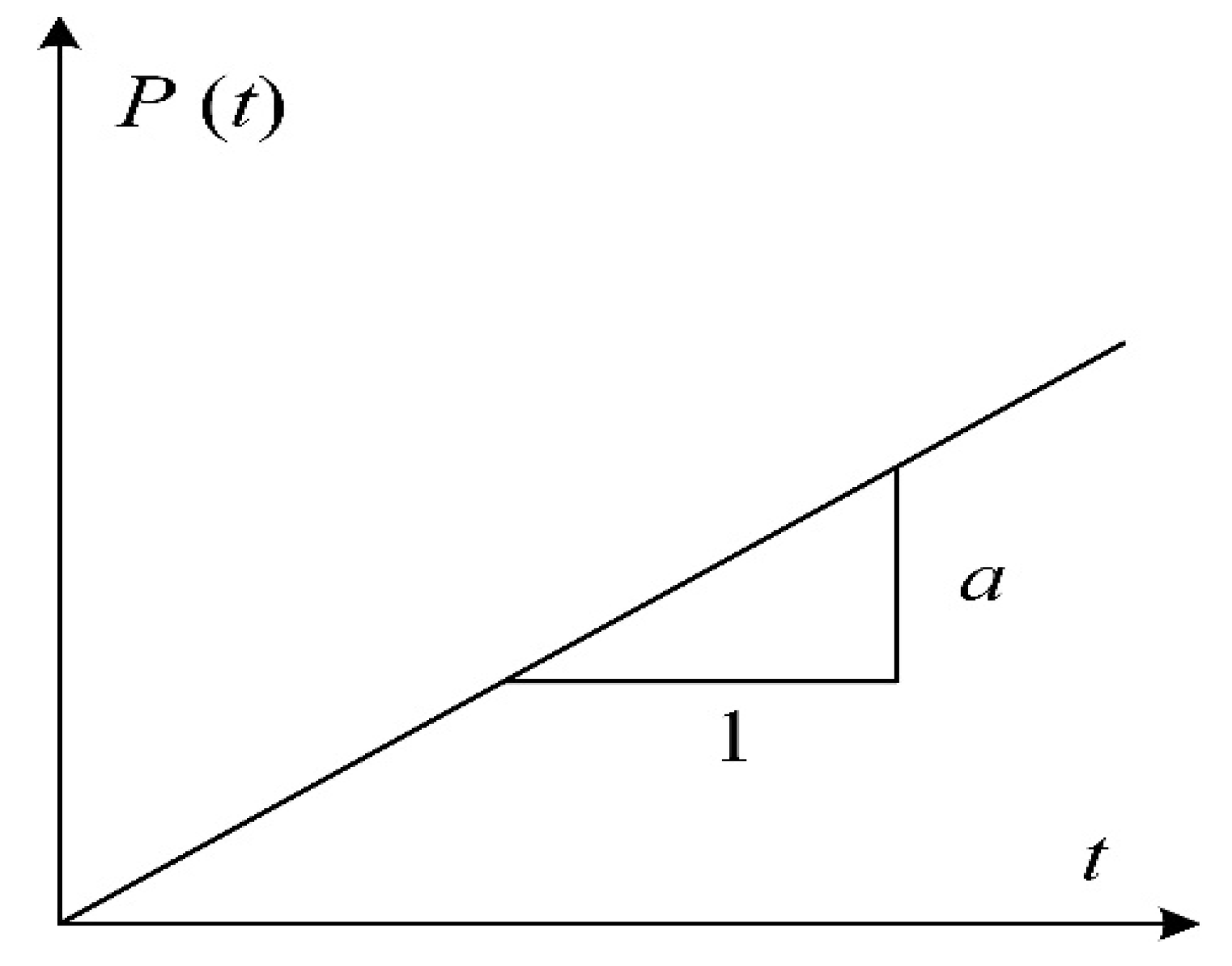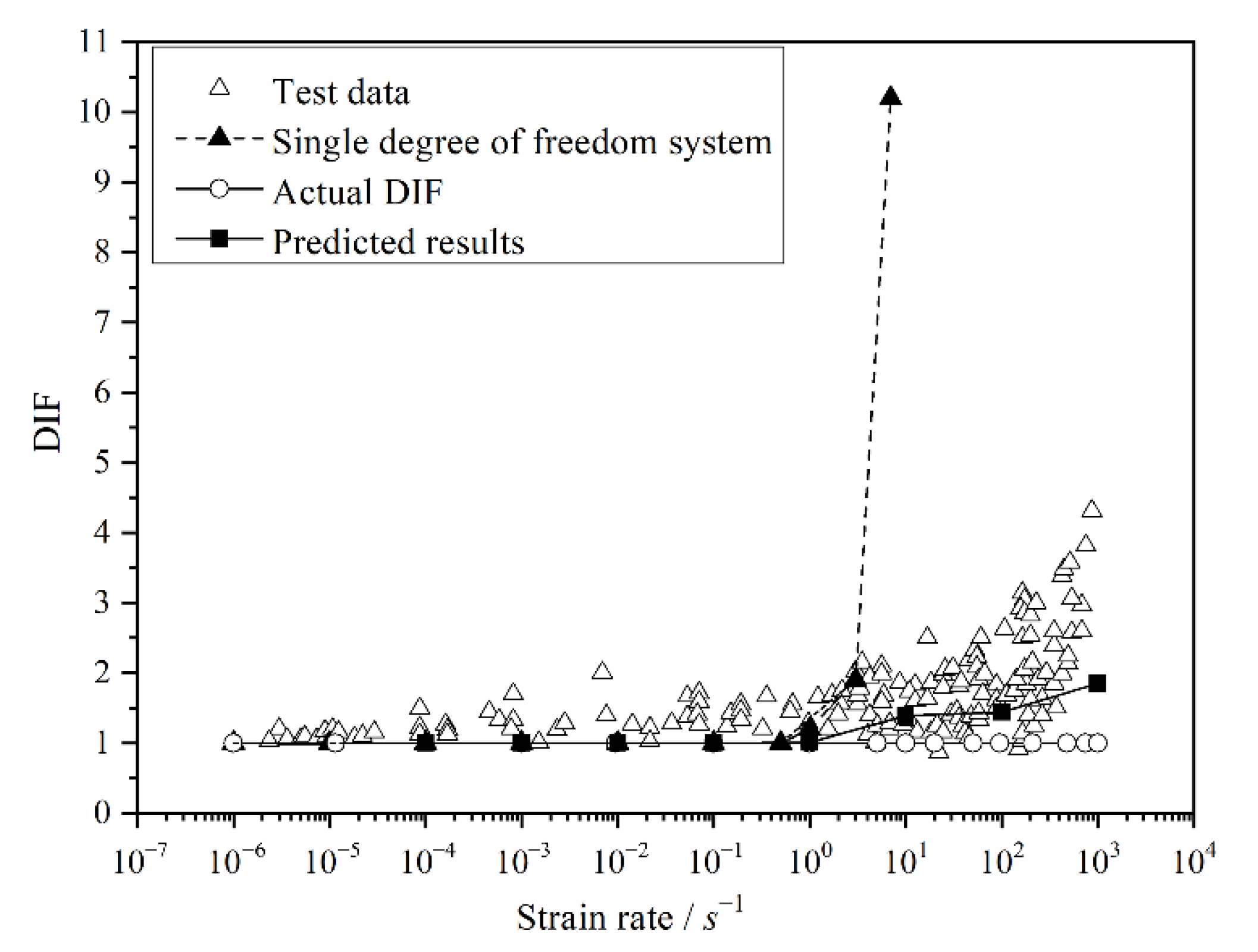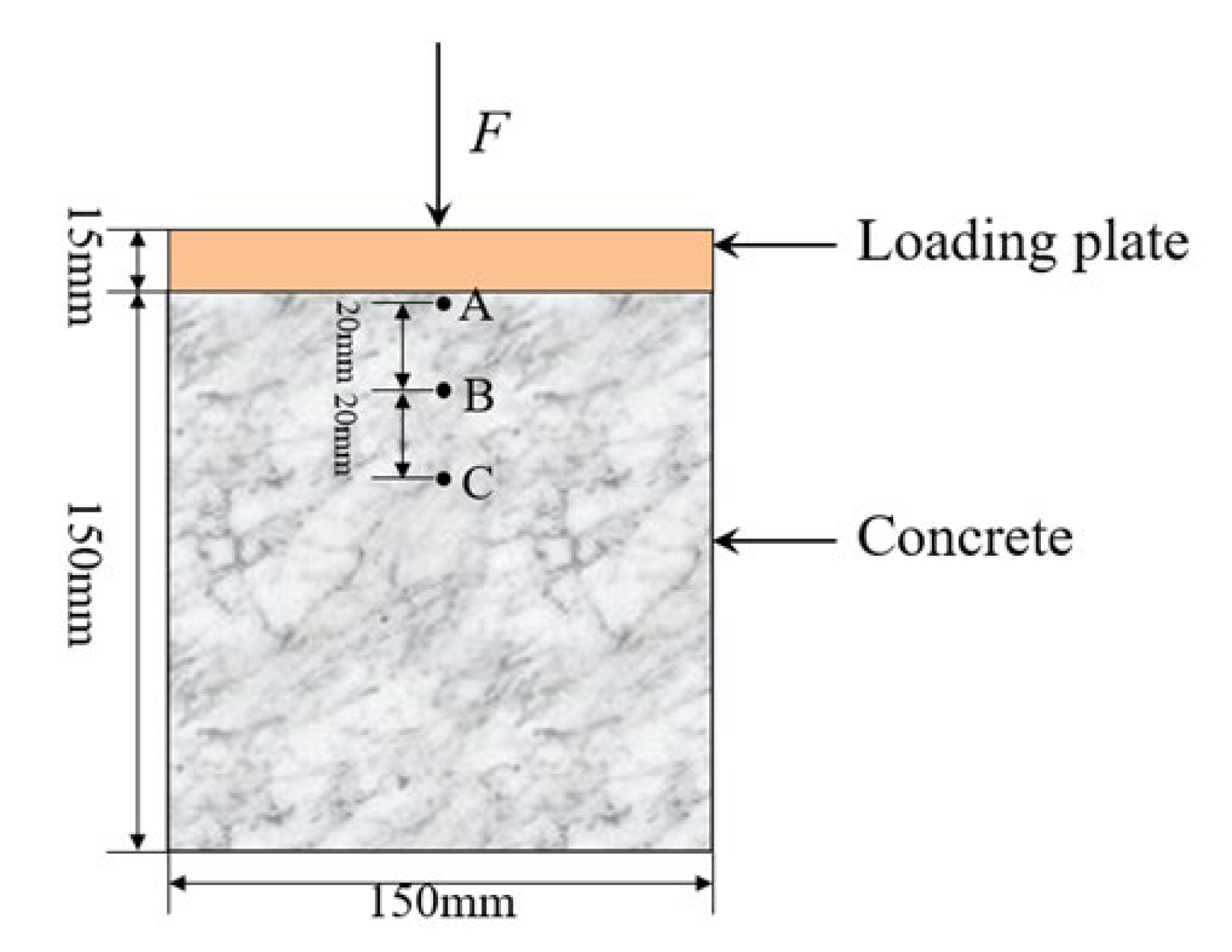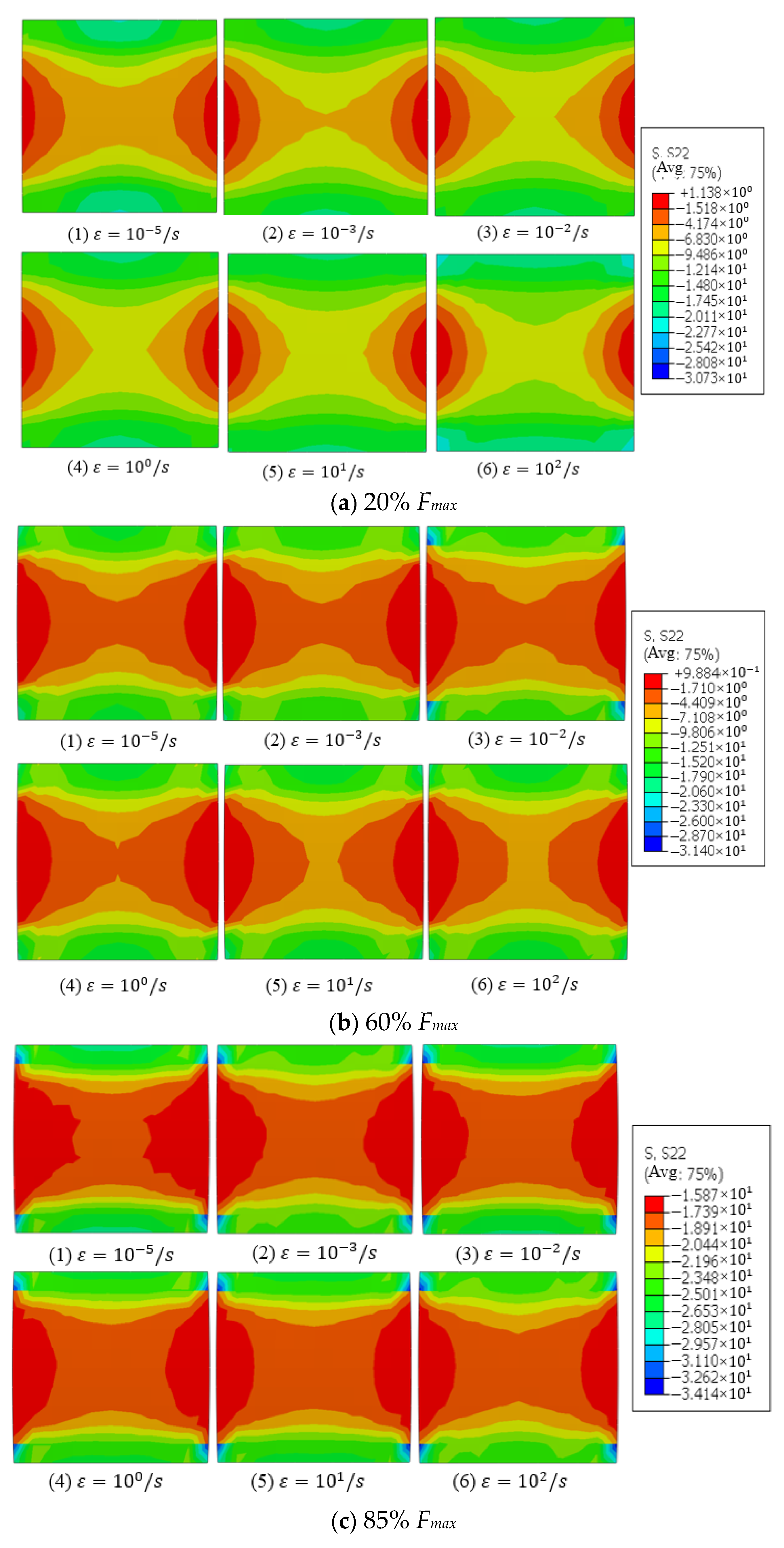Influence of Inertia on the Dynamic Compressive Strength of Concrete
Abstract
:1. Introduction
2. Experimental Procedures
2.1. Specimen Preparation
2.2. Test Produce
3. Results and Discussion
4. Analysis of Material Internal Stress during Dynamic Loading
5. Single Degree of Freedom Model of Structural Dynamic Response
6. Numerical Simulation of the Influence of Structure Inertia under Dynamic Loading
7. Conclusions
- (1)
- Under the influence of inertia, the stress near the loading end is larger than the far end, and the axial reaction force measured by the actuator is larger than the actual stress in concrete;
- (2)
- The effect of inertia on the nominal strength of concrete is related to the strain rate. When the strain rate is less than 1/s, the increase in DIF is small such that the inertial effect on the nominal concrete strength can be ignored, and the rate sensitive is mainly related to the viscous resistance of water in concrete, especially for wet concrete. When the strain rate is larger than 1/s, the nominal strength of concrete is greatly influenced by inertia;
- (3)
- In the structural dynamic equation, the effect of inertia on the dynamic response of concrete structures is considered. If the dynamic nominal strength of concrete is directly applied to evaluate the dynamic response of concrete structures, that may overestimate the influence of inertia on the capacity of concrete structures. However, whether the actual strength proposed in this study is appropriately applied, the structural analysis needs to be further studied.
Author Contributions
Funding
Institutional Review Board Statement
Informed Consent Statement
Data Availability Statement
Acknowledgments
Conflicts of Interest
References
- Bischoff, P.H.; Perry, S.H. Compressive behavior of concrete at high strain rates. Mater. Struct. 1991, 24, 425–450. [Google Scholar] [CrossRef]
- Hentz, S.; Donzé, F.V.; Daudeville, L. Discrete element modelling of concrete submitted to dynamic loading at high strain rates. Comput. Struct. 2004, 82, 2509–2524. [Google Scholar] [CrossRef]
- Shi, D.; Chen, X. Flexural tensile fracture behavior of pervious concrete under static preloading. J. Mater. Civil Eng. 2018, 30, 06018015. [Google Scholar] [CrossRef]
- Ghahari, S.; Assi, L.; Alsalman, A.; Alyamaç, K. Fracture Properties Evaluation of Cellulose Nanocrystals Cement Paste. Materials 2020, 13, 2507. [Google Scholar] [CrossRef]
- Abram, D.A. Effect of rate of Application of load on the compressive strength of concrete. Proc. ASTM 1917, 17, 364–377. [Google Scholar]
- Rossi, P.; Boulay, C. Influence of free-water in concrete on the cracking process. Mag. Concrete Res. 1990, 42, 143–146. [Google Scholar] [CrossRef]
- Rossi, P. Influence of cracking in the presence of free-water on the mechanical-behavior of concrete. Mag. Concrete Res. 1991, 43, 53–57. [Google Scholar] [CrossRef]
- Rossi, P.; Van Mier, J.G.M.; Toutlemonde, F. Effect of loading rate on the strength of concrete subjected to uniaxial tension. Mater. Struct. 1994, 27, 260–264. [Google Scholar] [CrossRef]
- Eibl, J.; Curbach, M. An attempt to explain strength increase due to high loading rates. Nucl. Eng. Des. 1989, 112, 45–50. [Google Scholar] [CrossRef]
- Bischoff, P.H.; Perry, S.H. Impact behavior of plain concrete loaded in uniaxial compression. J. Eng. Mech. 1995, 121, 685–693. [Google Scholar] [CrossRef]
- Georgin, J.F.; Reynouard, J.M. Modeling of structures subjected to impact: Concrete behaviour under high strain rate. Cement Concrete Comp. 2003, 25, 131–143. [Google Scholar] [CrossRef]
- Donze, F.V.; Magnier, S.A.; Daudeville, L. Numerical study of compressive behavior of concrete at high strain rates. J. Eng. Mech. 1999, 125, 1154–1163. [Google Scholar] [CrossRef]
- Zhou, X.Q.; Hao, H. Modelling of compressive behaviour of concrete-like materials at high strain rate. Int. J. Solids Struct. 2008, 45, 4648–4661. [Google Scholar] [CrossRef] [Green Version]
- Zhang, M.; Wu, H.J.; Li, Q.M. Further investigation on the dynamic compressive strength enhancement of concrete-like materials based on split Hopkinson pressure bar tests. Part I: Experiments. Int. J. Impact Eng. 2009, 36, 1327–1334. [Google Scholar] [CrossRef] [Green Version]
- Kim, D.J.; Sirijaroonchai, K.; El-Tawil, S. Numerical simulation of the Split Hopkinson Pressure Bar test technique for concrete under compression. Int. J. Impact Eng. 2010, 37, 141–149. [Google Scholar] [CrossRef]
- Mu, Z.C.; Dancygier, A.N.; Zhang, W. Revisiting the dynamic compressive behavior of concrete-like materials. Int. J. Impact Eng. 2012, 49, 91–102. [Google Scholar] [CrossRef]
- Zhang, M.; Li, Q.M.; Huang, F.L. Inertia-induced radial confinement in an elastic tubular specimen subjected to axial strain acceleration. Int. J. Impact Eng. 2010, 37, 459–464. [Google Scholar] [CrossRef]
- Li, Q.M.; Reid, S.R.; Wen, H.M. Local impact effects of hard missiles on concrete targets. Int. J. Impact Eng. 2005, 32, 224–284. [Google Scholar] [CrossRef]
- Li, Q.M.; Meng, H. About the dynamic strength enhancement of concrete-like materials in a split Hopkinson pressure bar test. Int. J. Solids Struct. 2003, 40, 343–360. [Google Scholar] [CrossRef]
- Li, Q.M.; Lu, Y.B.; Meng, H. Further investigation on the dynamic compressive strength enhancement of concrete-like materials based on split Hopkinson pressure bar tests. Part II: Numerical simulations. Int. J. Impact Eng. 2009, 36, 1335–1345. [Google Scholar] [CrossRef] [Green Version]
- Hao, Y.F.; Hao, H.; Li, Z.X. Numerical analysis of lateral inertial confinement effects on impact test of concrete compressive material properties. Int. J. Prot. Struct. 2010, 1, 145–168. [Google Scholar] [CrossRef]
- Hao, Y.; Hao, H.; Jiang, G.P. Experimental confirmation of some factors influencing dynamic concrete compressive strengths in high-speed impact tests. Cement Concrete Res. 2013, 52, 63–70. [Google Scholar] [CrossRef]
- Lu, Y.B.; Li, Q.M. About the dynamic uniaxial tensile strength of concrete-like materials. Int. J. Impact Eng. 2011, 38, 171–180. [Google Scholar] [CrossRef]
- Xu, H.; Wen, H.M. Semi-empirical equations for the dynamic strength enhancement of concrete-like materials. Int. J. Impact Eng. 2013, 60, 76–81. [Google Scholar] [CrossRef]
- Hao, Y.; Hao, H.; Zhang, X.H. Numerical analysis of concrete material properties at high strain rate under direct tension. Int. J. Impact Eng. 2012, 39, 51–62. [Google Scholar] [CrossRef]
- Hao, Y.F.; Zhang, X.H.; Hao, H. Numerical analysis of concrete material properties at high strain rate under direct tension. Procedia Eng. 2011, 14, 336–343. [Google Scholar] [CrossRef] [Green Version]
- Cotsovos, D.M.; Pavlović, M.N. Numerical investigation of concrete subjected to compressive impact loading Part 2: Parametric investigation of factors affecting behaviour at high loading rates. Comput. Struct. 2008, 86, 164–180. [Google Scholar] [CrossRef]
- Kotsovos, M.D. Structural-concrete analysis and design: Need for a sound underlying theory. Arch. Appl. Mech. 2012, 82, 1439–1459. [Google Scholar] [CrossRef]
- Dan, Z.; Li, Q. An Explanation for Rate Effect of Concrete Strength Based on Fracture Toughness Including Free Water Viscosity. Eng. Fract. Mech. 2004, 71, 2319–2327. [Google Scholar]
- Zheng, D.; Wang, H.; Li, Q. Mechanism of inertia and viscosity effects on concrete strength under dynamic loading. J. Hydroelectr. Eng. 2018, 37, 85–93. (In Chinese) [Google Scholar]
- Eringen, A.C.; Suhubi, E.S. Elastodynamics; Academic Press: New York, NY, USA, 1975; Volumes I–II. [Google Scholar]
- Lee, J.; Fenves, G.L. Plastic-damage model for cyclic loading of cement structures. J. Eng. Mech. 1998, 8, 892–900. [Google Scholar]









| Number of Specimens | Moisture Content | Loading Rate | Frame per Second |
|---|---|---|---|
| D1 | Dry | 10−5/s | 1 |
| D2 | Dry | 10−4/s | 2 |
| D3 | Dry | 10−3/s | 5 |
| D4 | Dry | 10−2/s | 10 |
| S1 | Saturated | 10−5/s | 1 |
| S2 | Saturated | 10−4/s | 2 |
| S3 | Saturated | 10−3/s | 5 |
| S4 | Saturated | 10−2/s | 10 |
| Density (kg/m3) | Elastic Modulus (GPa) | Poisson’s Ratio | Dilatancy Angle | Eccentricity | ||
|---|---|---|---|---|---|---|
| 2500 | 32.5 | 0.2 | 35 | 0.1 | 1.16 | 0.6667 |
Publisher’s Note: MDPI stays neutral with regard to jurisdictional claims in published maps and institutional affiliations. |
© 2022 by the authors. Licensee MDPI, Basel, Switzerland. This article is an open access article distributed under the terms and conditions of the Creative Commons Attribution (CC BY) license (https://creativecommons.org/licenses/by/4.0/).
Share and Cite
Qin, Z.; Zheng, D.; Li, X.; Wang, H. Influence of Inertia on the Dynamic Compressive Strength of Concrete. Materials 2022, 15, 7278. https://doi.org/10.3390/ma15207278
Qin Z, Zheng D, Li X, Wang H. Influence of Inertia on the Dynamic Compressive Strength of Concrete. Materials. 2022; 15(20):7278. https://doi.org/10.3390/ma15207278
Chicago/Turabian StyleQin, Zhangchen, Dan Zheng, Xinxin Li, and Haicui Wang. 2022. "Influence of Inertia on the Dynamic Compressive Strength of Concrete" Materials 15, no. 20: 7278. https://doi.org/10.3390/ma15207278
APA StyleQin, Z., Zheng, D., Li, X., & Wang, H. (2022). Influence of Inertia on the Dynamic Compressive Strength of Concrete. Materials, 15(20), 7278. https://doi.org/10.3390/ma15207278





